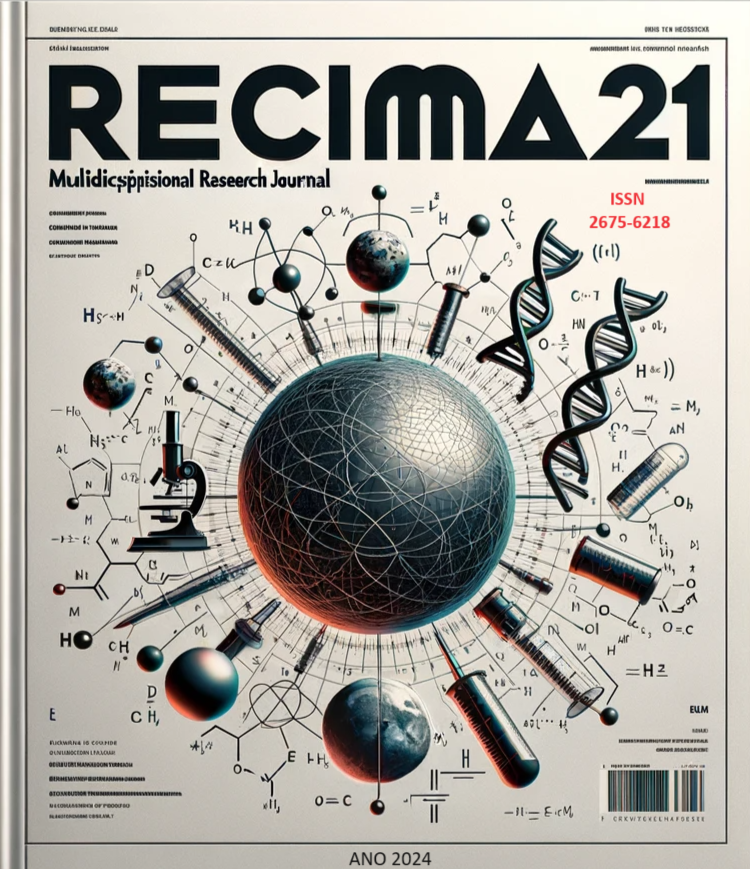COGNIÇÃO SOCIAL, IMAGINAÇÃO COLETIVA, ARTES E ZEITGEIST
DOI:
https://doi.org/10.47820/recima21.v5i2.4840Palavras-chave:
Cognição. Imaginação. Arts. Zeitgeist. Idioma. Metáfora.Resumo
Cognição e imaginação são faculdades humanas que frequentemente são entendidas como processos individuais. Nas últimas décadas, no entanto, têm sido estudadas como uma experiência coletiva. Cognição e imaginação são tão fortemente ligadas a corpo e mente que caracterizam o que significa ser humano. Corpo, cérebro, cognição e imaginação são, por outro lado, relacionadas com cultura; a cultura é manifestada pela Arte. Nós propomos que a Arte comunitária reflete seu próprio Zeitgeist e muda com as mudanças da cognição coletiva. Assim, as pessoas continuamente modificam seu entendimento delas mesmas e do mundo. Neste trabalho descrevemos a transformação das Artes da Idade Média ao Renascimento, quando as Artes se tornaram conhecidas por seus autores em cada trabalho individualizado. Concomitantemente, avanços na Medicina levaram ao desenvolvimento da Anatomia humana detalhada, na medida em que a Perspectiva passou a ser visualizada. Modificações do Renascimento ao Barroco também acompanharam a manifestação dos movimentos do corpo nas Artes e a Fisiologia emergiu na Medicina, conjuntamente com mudanças na cognição e na imaginação coletiva.
Downloads
Referências
BAAKE, K. Metaphor and Knowledge, The Challenges of Writing Science. Albany, NY: State University of New York Press, 2003. DOI: https://doi.org/10.1353/book4677
BRAMLY, S. Leonardo da Vinci, 1452-1519. Rio de Janeiro, RJ: Imago Editora, 1989.
DEMARIN, V.; BEDEKOVIĆ, M. R.; PURETIĆ, M. B.; PAŠIĆ, M. B. Arts, Brain, and Cognition. Psychiatr Danub., v. 28, n. 4, p. 343-348, dec. 2016.
DURAND, G. The Anthropological Structures of the Imaginary. Sao Paulo, SP: Editora Martins Fontes, 2012.
ECO, U. Art and Beauty in the Middle Ages. Rio de Janeiro, RJ: Editora Record, 1987.
FINGER, S. Origins of Neuroscience: A History of Explorations into Brain Function. New York, NY: Oxford University Press, 1994. DOI: https://doi.org/10.1093/oso/9780195065039.001.0001
HALLYN, F. The Poetic Structure of the World, Copernicus and Kepler. New York: Zone Books, 1990.
HAWLINA, H.; PEDERSEN, O. C.; ZITTOUN, T. Imagination, and social movements. Curr Opin Psychol., v. 35, p. 31-35, oct. 2020. doi: 10.1016/j.copsyc.2020.02.009. DOI: https://doi.org/10.1016/j.copsyc.2020.02.009
HOOKE, R. Micrographia: or some physiological descriptions of minute bodies made by magnifying glasses. London, UK: The Royal Society, 1665. DOI: https://doi.org/10.5962/bhl.title.105738
HUERTAS, R. The Century of Clinics. Zaragoza, Spain: Novalia Electronic Editions, 2004.
KESNER. L. A hole in piece of carboard and predictive brain: the incomprehension of modern art in the light of the predictive coding paradigm. Phil. Trans. R. Soc. B, v. 379, p. 20220417, 2023. https://doi.org/10.1098/rstb.2022.0417 DOI: https://doi.org/10.1098/rstb.2022.0417
KUHN, T. S. The Copernican Revolution, Planetary Astronomy in the Development of Western Thought. Cambridge, MA: Harvard University Press, 1957.
MELI, D. B. Mechanism, Experiment, Disease: Marcello Malpighi and Seventeenth Century Anatomy. Baltimore, MD: The Johns Hopkins University Press, 2011. DOI: https://doi.org/10.1353/book.1842
MOMENNEJAD, I. Collective minds: social network topology shapes collective cognition. Philos Trans R Soc Lond B Biol Sci., v. 377, n. 1843, p. 20200315, 31 jan. 2022. doi: 10.1098/rstb.2020.0315. DOI: https://doi.org/10.1098/rstb.2020.0315
MONGELLI, L. M. et al. Trivium and Quadrivium, The Liberal Arts in Middle Ages. Cotia, SP: Editora Ibis, 1999.
OERGEL, M. Zeitgeist. How Ideas Travel. Berlin: De Gruyter, 2019. DOI: https://doi.org/10.1515/9783110631531
PANOFSKY, E. Meaning in the Visual Arts. Sao Paulo, SP: Editora Perspectiva, 1955.
PANOFSKY, E. Perspective as Symbolic Form. New York, NY: Zone Books, 1977.
ROSSI, P. Science and Philosophy of Modern. Sao Paulo, SP: Editora Unesp, 1989.
RÜEGG, W. “Themes,” in A History of the University in Europe, Ed. Hilde De Ridder-Simoens. Cambridge, UK: Cambridge University Press, 1992. p. 3-34.
SCHWARTZ-SALANT, N. The Mystery of Human Relationship – Alchemy and the Transformation of the Self. London: Routledge, 1998.
SENNET, R. Flesh and Stone: The Body and the City in Western Civilization. New York: W.W. Norton & Company, 1997.
TUBBS, R. S. Anatomy is to physiology as geography is to history; it describes the theatre of events. Clinical Anatomy, v. 28, n. 2, p. 151, 2015. doi:10.1002/ca.22526. DOI: https://doi.org/10.1002/ca.22526
VASARI, G. Vidas dos Artistas. São Paulo, SP: Editora Martins Fontes, 2020.
WÖLFFLIN, H. Principles of Art History: The Problem of the Development of Style un Later Art. Mineola, NY: Dover Publications, Inc, 1929.
ZITTOUN, T.; CERCHIA, F. Imagination as expansion of experience. Integr Psychol Behav Sci., v. 47, n. 3, p. 305-24, sep. 2013. doi: 10.1007/s12124-013-9234-2. PMID: 23625542. DOI: https://doi.org/10.1007/s12124-013-9234-2
Downloads
Publicado
Licença
Direitos de Autor (c) 2024 RECIMA21 - Revista Científica Multidisciplinar - ISSN 2675-6218

Este trabalho encontra-se publicado com a Licença Internacional Creative Commons Atribuição 4.0.
Os direitos autorais dos artigos/resenhas/TCCs publicados pertecem à revista RECIMA21, e seguem o padrão Creative Commons (CC BY 4.0), permitindo a cópia ou reprodução, desde que cite a fonte e respeite os direitos dos autores e contenham menção aos mesmos nos créditos. Toda e qualquer obra publicada na revista, seu conteúdo é de responsabilidade dos autores, cabendo a RECIMA21 apenas ser o veículo de divulgação, seguindo os padrões nacionais e internacionais de publicação.













